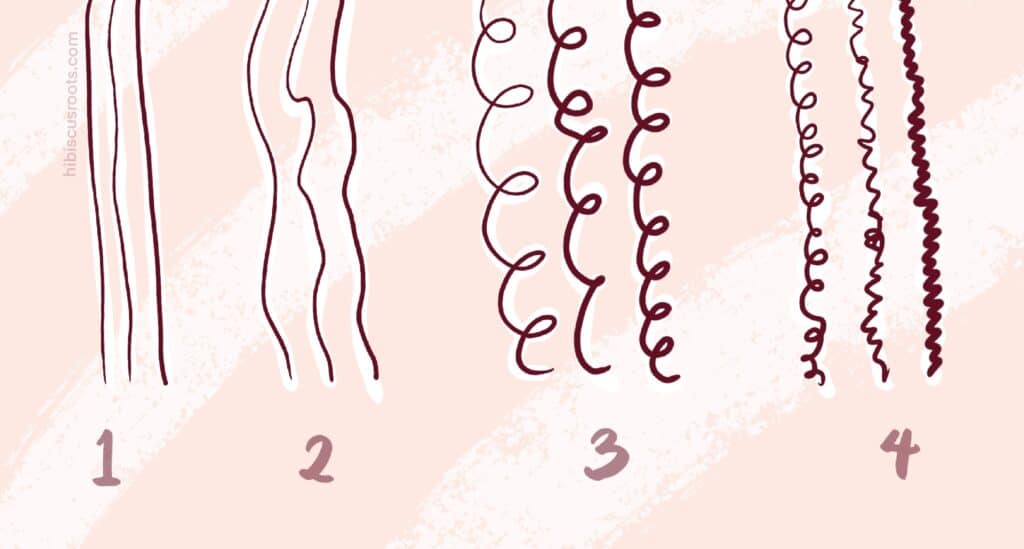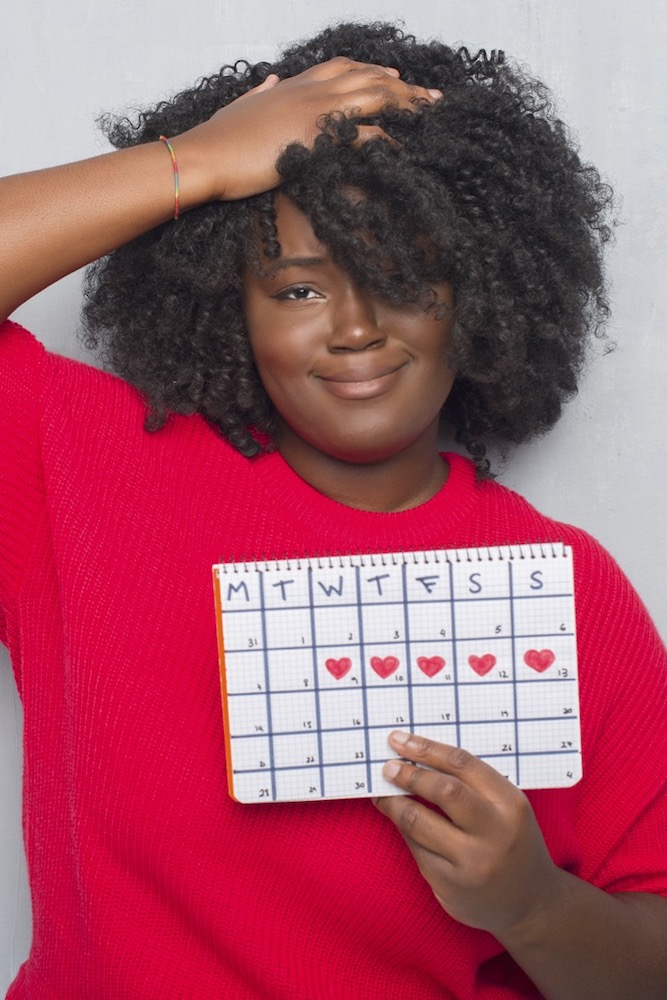Updated: January 22, 2021
If you’re wondering about your curly hair type or your curl patterns (our chart makes this easy :)) — you’re in the right aisle.
I’m giving you all the information I wish I had when I was just starting out my natural hair journey and was curious about my hair.
You may have already seen the hair type charts for curly hair or tried to copy regimens from girls whose hair looks like yours. All for it to not turn out quite as you planned.
Well, in this post, I’m really going to dive into the basics. I will be explaining the full hair profile and why solid knowledge of your hair profile is the first step to a stress-free hair journey.
What is Your Full Hair Profile
Your full curly hair profile is made up of all the elements that make your hair unique. It consists of the following aspects:
- Curl Pattern
- Hair Density
- Hair Porosity
- Thickness or Size of Hair
Curl Patterns (Chart, Typing Systems, etc)
Your curl pattern is the shape of your hair strand. This is largely determined by your genetics. Different curl patterns form from the shape and size of your hair follicles. Larger, rounder follicles produce straighter hair — while smaller, flatter follicles produce coily hair.
The best imagery I’ve found that describes this to imagine squeezing paste out of a tube. The wider the nozzle, the more uniform the product!
The widely popular Texture Typing system often lumps similar curl patterns into what we know as hair types. Curl patterns range from straight to coily, while hair types range from 1 to 4. These 4 hair types also have 3 sub-types within them ranging from A-C.
The Four Curly Hair Types are:
- Type 1 Hair: Straight Hair
- Type 2 Hair: Wavy Hair
- Type 3 Hair: Curly Hair
- Type 4 Hair: Coily – Kinky Hair
A Chart of the 4 Curl Patterns
The following curl patterns chart that illustrates the difference in curly hair type:

Each of the curl patterns on the chart range from A to C, going from looser (A) to tighter (B) curls, within each type. i.e. there are hair types 1A, 1B, 1C; 2A, 2B, 2C; 3A, 3B, 3C; and 4A, 4B, 4C.
You can see more visual examples of these hair types here.
Another way to categorize curl patterns is by the LOIS Hair typing system.
This categorizes curl patterns into hair that is literally shaped like an “L”, “O”, “I” or “S”. You may also have a combination of multiple types of hair. After this, you would then determine whether or not your hair is thready, wiry, cottony, spongy, or silky. You can find in-depth explanations of these categories here.
How to Change Your Curl Pattern
Now the question a lot of people ask is whether or not you can change your curl pattern.
The only way you can change your curl pattern is with chemical treatments, like relaxers and gina curls. However, when your hair grows out from its roots, it will still grow out in its natural shape (curl pattern).
Some people also believe that your curl pattern changes over time. This is also only partially true. As your curls grow out, their weight may pull them down and “stretch” them. If you decide to cut your hair, it will look just like it did before.
Here’s a quiz you can use to figure out your curl pattern and curly hair type!
You can also see the chart above for a visual representation of your curl patterns.
You should note that knowing your curl pattern is only the first part of knowing and understanding your hair. However, most people just stop here. You’re not most people!
Keep reading and you’re going to learn so much about your hair and find a deeper sense of balance (Ayurveda) when it comes to caring for your hair.
Hair Density
Your hair’s density refers to the actual number of strands on your hair. This is also defined by your genetics. However, it can be affected by things like alopecia and hair loss from various causes.
Though you are not expected to literally count the number of strands on your hair, to find out. There are ways to deduce your hair’s density by simple observation.
- Part your hair and look at your scalp.
If you have a lot of scalp visible between your strands, then your hair is low density. However, if your scalp is barely visible and your follicles are really tightly packed together on your scalp, then your hair is high density. - Look at your ponytails, buns or puffs
If you struggle to have a nice full puff and need to fluff your hair out a lot to get a good size, you may have low-density hair. However, if at any length you puffs are always super thick or full, then your hair may be highly dense.
Amla is a great Ayurvedic herb that can help naturally increase the density of your scalp! According to this 2012 study, Amla prevents hair loss / improves hair density by inhibiting 5-alpha reductase. This is the same hormone that is blocked by finasteride, a medication that treats male pattern baldness.
Hair Porosity
The porosity of your hair is defined as how easy it is for water and product to penetrate your hair shaft. Hair porosity ranges from low porosity, medium porosity, to high porosity.
Your hair porosity can be affected by several factors including:
- Genetics
- The current state of your hair (bleached, heat damaged, heat trained, etc)
- The products you’re using and,
- Your hair regimen.
Certain products like henna and protein can fill up the gaps in your hair, to make it less porous. However, other products like chemical bleach and perms breakdown the proteins in your hair and make it more porous.
You can find out your hair’s porosity either using the float test, or the slip n slide method. For more detailed instructions, see the post we have on hair porosity that takes a deep dive into it!
Hair Thickness
The thickness of your hair refers to the width of your individual hair strands. So these strands can range from fine, to coarse.
People often mistake high-density hair for thick hair. But in truth, your hair can be highly dense but made up of really fine strands. Or really thick, but only sparsely cover your hair.
An Ayurvedic herb that is well known for its ability to thicken hair is Henna – read more about that here. This is because when applied to your hair, henna is deposited on the surface of your hair. It fills the holes and gaps along the cuticle and reinforces your strands.
Hair Profile Falls Within a Range
What’s important to note is that most of these measures fall within a range. Most people don’t have a full head of hair that falls squarely in one category. For example, here’s my hair profile:
- Curl Pattern: I have hair that is mostly 4C, but the nape section of my hair is 4B.
- Hair Density: My hair is medium to high density in most parts of my hair. It is low density on the temples of my head near my edges.
- Hair Porosity: I used to have high porosity, but with consistent use of henna in my regimen, it is now medium porosity.
- Hair Thickness: My hair is mostly medium thickness, but I do have some coarse strands in parts of my head. However, it is finer right at the front of my hairline and around my edges.
Why Knowing Your Full Hair Profile is So Important
It is important to know your hair profile so that you understand your hair better. This is the best way to find a hair care regimen and products that work for you.
- You make better product choices:
You won’t waste so much money buying products that won’t work for your hair. Hair milks and mists, for example, will do little to nothing for moisturizing kinky, highly dense, high porosity thick hair. While heavy hair butters will do more damage than good to fine or low porosity strands by either weighing them down or causing product build-up. - You have set expectations:
When you know exactly what your hair is like you don’t put too much pressure on it to do what it can not. There are certain styles and looks that some types of hair can achieve and others can not.
When you don’t understand your hair profile you can look at a YouTuber that has 4c hair, do exactly what she does, and use exactly the same products she does, and wonder why your hair still doesn’t come out the same.
She may have hair that looks exactly like yours when it comes to its curl pattern, but be completely different when it comes to every other category.
In the end, knowing your curl pattern or your curly hair type is just a fraction of understanding your hair. Armed with these 3 other aspects of your hair type, I know you’ll be on the right path to fully understand your hair profile and how you can take better care of it!
The next thing you want to read is our Ultimate Guide to Ayurvedic hair care!


